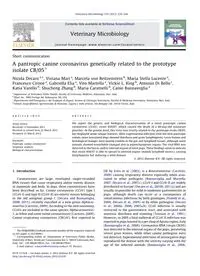
2012 A pantropic canine coronavirus genetically related to the prototype isolate CB_05 PDF
Preview 2012 A pantropic canine coronavirus genetically related to the prototype isolate CB_05
Short communication A pantropic canine coronavirus genetically related to the prototype isolate CB/05§ Nicola Decaro a,*, Viviana Mari a, Marcela von Reitzenstein b, Maria Stella Lucente a, Francesco Cirone a, Gabriella Elia a, Vito Martella a, Vickie L. King b, Antonio Di Bello c, Katia Varello d, Shucheng Zhang b, Maria Caramelli d, Canio Buonavoglia a a Department of Veterinary Public Health, Faculty of Veterinary Medicine, Valenzano, Bari, Italy b Pfizer Inc, 7000 Portage Rd, Kalamazoo, MI, USA c Dipartimento dell’Emergenza e dei Trapianti di Organi, Sezione di Chirurgia Veterinaria, Facolta` di Medicina Veterinaria, Valenzano, Bari, Italy d Istituto Zooprofilattico Sperimentale di Piemonte, Liguria e Valle d’Aosta, Via Bologna 148, 10154 Torino, Italy 1. Introduction Coronaviruses are large, enveloped, single-stranded RNA viruses that cause respiratory and/or enteric disease in mammals and birds. In dogs, three coronaviruses have been described so far. Canine coronavirus (CCoV) type I (CCoV-I) and type II (CCoV-II) are enteric viruses belonging to the old antigenic group 1 (Decaro and Buonavoglia, 2008, 2011), recently classified as a new genus Alphacor- onavirus (Carstens, 2009). According to the new taxonomy, CCoVs are included in the same species, Alphacoronavirus- 1, as feline and some swine coronaviruses (Carstens, 2009). Canine respiratory coronavirus (CRCoV), first reported in UK by Erles et al. (2003), is a Betacoronavirus (Carstens, 2009) causing respiratory distress especially when asso- ciated to other pathogens (Buonavoglia and Martella, 2007; Decaro et al., 2007c). CCoV-I and CCoV-II are widely distributed in Europe (Decaro et al., 2010b, 2011a) and are usually responsible for mild to moderate gastroenteritis in pups, although death can occur as a consequence of simultaneous infections by both genotypes (Pratelli et al., 2004; Decaro et al., 2005) or by other pathogens (Decaro et al., 2004a, 2006, 2007a,b). CCoV infection is usually restricted to the gastroenteric tract, and associated with anorexia, diarrhoea and vomiting (Tennant et al., 1991). However, in 2005 a fatal outbreak of CCoV-II infection was reported in pups housed in a pet shop of Apulia region, Italy (Buonavoglia et al., 2006). Coronavirus RNA (strain CB/05) was detected in the internal organs of the pups, presenting severe gross lesions, while other canine pathogens were not detected. Experimental infections of seronegative dogs reproduced the disease with the severity varying with the age of the infected animals (Buonavoglia et al., 2006; Veterinary Microbiology 159 (2012) 239–244 A R T I C L E I N F O Article history: Received 13 December 2011 Received in revised form 22 March 2012 Accepted 23 March 2012 Keywords: Pantropic canine coronavirus Sequence analysis Biological characterisation A B S T R A C T We report the genetic and biological characterisation of a novel pantropic canine coronavirus (CCoV), strain 450/07, which caused the death of a 60-day-old miniature pinscher. At the genetic level, this virus was strictly related to the prototype strain CB/05, but displayed some unique features. After experimental infection with the new pantropic isolate, most inoculated dogs showed diarrhoea and acute lymphopenia. Gross lesions and histological changes were mainly evident in the gut and lymphoid tissues, although some animals showed remarkable changed also in parenchymatous organs. The viral RNA was detected in the faeces and/or internal organs of most pups. These findings seem to indicate that strain 450/07 is able to spread to internal organs (mainly lymphoid tissues), causing lymphopenia but inducing a mild disease. � 2012 Elsevier B.V. All rights reserved. § The DDBJ/EMBL/GenBank accession number of the sequence reported in this paper is GU146061. * Corresponding author at: Department of Veterinary Public Health, University of Bari, Strada per Casamassima km 3, 70010 Valenzano, Bari, Italy. Tel.: +39 0804679832; fax: +39 0804679843. E-mail address:
